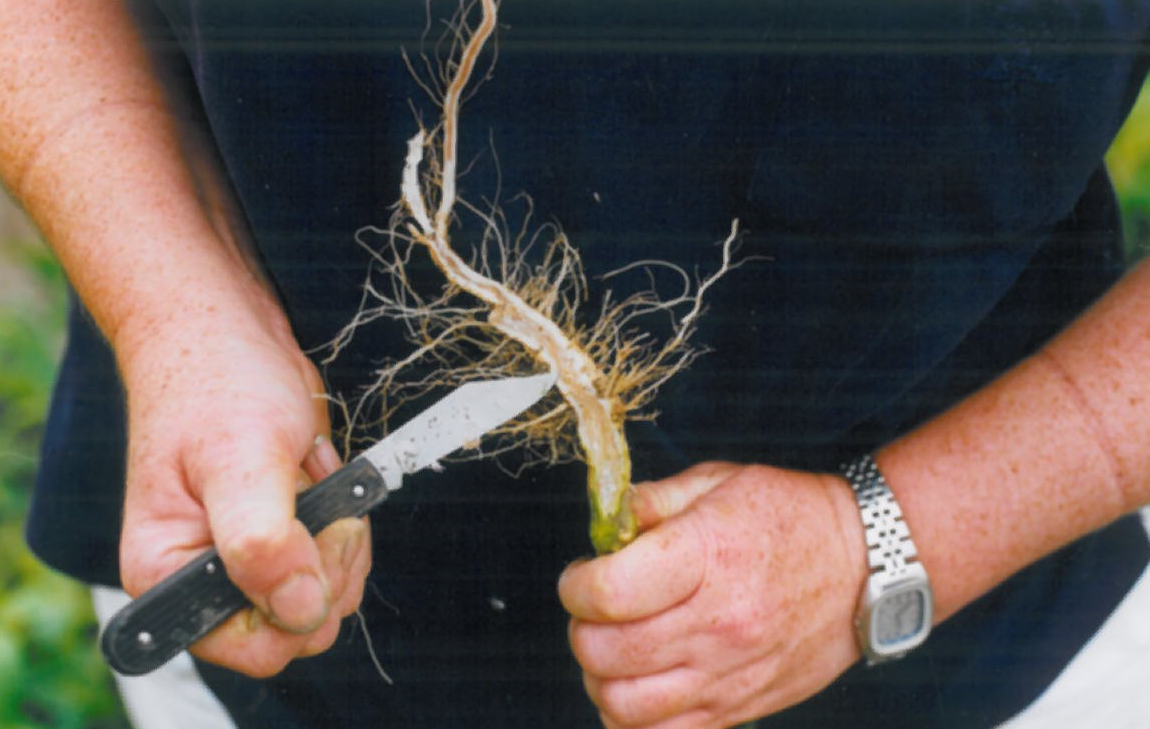Phytophthora root rot of tomatoes
Root rot of the processing tomatoes industry was associated with Phytophthora nicotianae var. nicotianae, which is a fungus-like water mould, technically called an 'oomycete'. It has been a widespread problem, affecting direct-seeded, furrow irrigated crops and crops subject to flooding after heavy rains.
Yield losses due to root rot can account for 25% of the total annual production. Losses to individual growers might even be higher.
Symptoms of the disease
The above-ground symptoms of the disease include:
- a stunted appearance
- wilt
- the die-back of tops
- buckeye rot of fruit.
Phytophthora usually infects the tap roots with symptoms of a brown discolouration in the vascular tissue, often close to the crown (see photograph).
 In severe cases, the tap root might be cut off completely by the rot. Sometimes, a mass of fibrous roots will develop at the crown to compensate for the loss of the tap root.
In severe cases, the tap root might be cut off completely by the rot. Sometimes, a mass of fibrous roots will develop at the crown to compensate for the loss of the tap root.
When severely diseased plants are water-stressed (for example, under hot, windy conditions) the tops will wilt and the plants might die.
Buckeye rot of green and ripe fruit has symptoms of a brown, firm rot, with water-soaked lighter coloured margins. It can occur when fruit are in contact with the ground or sitting in water.
Young seedlings can also be affected by the disease. Symptoms in seedlings include the collapse of the stem near the base of the plant.
Controlling root rot
In the past, many growers have managed to avoid severe disease outbreaks by long crop rotations or leasing new ground for tomatoes. But as new land becomes scarcer, growers are forced to look for alternative control measures.
Research has shown that certain soil-applied systemic chemicals have potential as short-term treatments for root rot.
Because Phytophthora grows best in saturated soil, you'll reduce the incidence and severity of the disease if you take steps to:
- improve soil drainage – such as with soil amelioration with gypsum and by increasing the height of beds
- minimise the period required for each irrigation
- avoid over-watering, especially during early stages of crop development – seedlings don't require as much water as mature plants and seedlings appear to be more susceptible to severe disease.
The period of furrow irrigation can be shortened by:
- increasing the slope or fall of the paddock
- reducing the length of the run.
Alternative irrigation practices such as trickle irrigation can also provide more precise water management.
Spread of disease
Phytophthora exists as resting spores in the soil.
When the soil is moist, these resting spores can develop sac-like structures known as sporangia. These contain many swimming spores (zoospores).
When the soil is saturated, zoospores are released and will swim to nearby tomato roots.
As roots become infected and the disease develops, more sporangia develop in the infected root tissues and the cycle of zoospore release and root infection continues through the growing season.
Environmental conditions
Phytophthora nicotianae grows most rapidly at 25°C to 28°C – temperatures often encountered in the field during the tomato-growing season in Victoria.
Phytophthora develops best in saturated soil conditions created by irrigation or rainfall. This is because zoospores can swim in the water-filled pores between the soil particles.
Prolonged irrigation or waterlogging can reduce soil oxygen levels, which increases the severity of root rot. Soils that have slow water penetration or poor drainage will also provide ideal conditions for disease.
Survival of Phytophthora
Little is known about the survival of Phytophthora in soil, but tomato crops are known to be affected by the disease even after a 6-year rotation.
Reporting an unusual plant insect pest or disease
Report any unusual plant pest or disease immediately using our online reporting form or by calling the Exotic Plant Pest Hotline on 1800 084 881. Early reporting increases the chance of effective control and eradication.
Please take multiple good quality photos of the pests or damage to include in your report where possible, as this is essential for rapid pest and disease diagnosis and response.
Your report will be responded to by an experienced staff member, who may seek more information about the detection and explain next steps.
Report onlineReferences
Flett S (1986) Phytophthora micotianae var. nicotianae causing root and crown rot of direct seeded tomatoes in Victoria. Australiasian Plant Pathology 15:11-13.